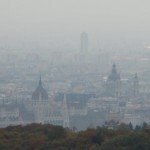From Guest Blogger Devin Morrissey: Tips for Healthy Living in High-Pollution Areas

Air pollution has countless negative effects on your health. It can lead to respiratory problems, heart attacks, cancer, and a shortened lifespan. In fact, it is linked to 1 in 8 deaths worldwide.
If you live in a high-pollution area, what can you do to protect your health? Here are a few tips for those looking to avoid these severe health risks:
Maintain Your Eyesight
As I’ve noted before on 2GreenEnergy, toxic air pollution can have a negative effect on your eyes. Pollution — consisting of carbon monoxide, nitrogen dioxide, dust, and various allergens — can cause you to have dry eyes. Common symptoms of dry eye can include dryness, grittiness, irritation, soreness, burning and eye fatigue. This condition can cause long-term damage to your eyesight.
If you live in a high-pollution area, it only makes sense to take measures to protect your eyes. Here are a few steps you can take:
- Regularly check your region’s area quality index (AQI) and plan your day accordingly. If the value is below 50, the air quality is ideal for outdoor activities. If it reaches 100 or greater, it can be dangerous for particularly sensitive individuals. A score of 200 to 300 is very unhealthy, and anything above 300 is hazardous. Stay indoors during days with particularly a particularly high AQI.
- If you need to be outside during a particularly bad day, wear sunglasses or other protective eyewear. Use eye drops as necessary to keep your eyes moisturized.
- Frequently wash your hands and avoid touching your eyes.
- Stay hydrated — this will help you produce enough tears to keep your eyes healthy. Most experts recommend that, on average, men should drink at least 104 ounces of water per day, while women should drink at least 72 ounces. Just be wary — polluted areas may have contaminated water, which can carry waterborne pathogens.
Get Better Sleep
Having trouble getting enough sleep at night? Pollution could be the problem. A Live Science article discusses recent research that discovered a link between pollution and chronic sleep deprivation, and it is certainly eye-opening. The researchers hypothesize that air pollution could cause airway irritation and that particles of pollution could enter the bloodstream (interfering with sleep regulation). The result? One fitful night of sleep after another, leading to sleep deprivation and a wide range of associated negative health risks.
If the air is keeping you up a night, here are some measures you can take to get a little more shut-eye:
- Take steps to reduce indoor air pollution. Regularly clean to remove mold, dust, and pollen, but avoid using harsh household cleaning chemicals, which can irritate your respiratory system.
- Regularly change your air filters; in high-pollution areas, you may need to replace them more often than usual. Ensure that there is plenty of ventilation, and obviously, don’t allow smoking in your home.
- Keep in mind that pollution, including dust and allergens, can accumulate on your sheets and in your mattress. These can have a serious impact on your quality of sleep. Experts with Mattress Advisor recommend cleaning sheets once a week. They also suggest vacuuming your mattress to get rid of dust mites and other allergens on a regular basis (every 1-3 months).
Monitor Your Health
Wearable technology and health applications have changed the way consumers monitor their health and take preventative health actions, and the influence of this tech will grow as new innovations make their way to the market. A resource by Bradley University explains, “These apps have benefits that range from general support and instruction to helping people who suffer from chronic illnesses or diseases be more accountable for their own well-being … (They) can really assist people to make positive changes in their day-to-day habits.”
There are many options for those looking to pursue healthier living in high-pollution areas. Here are a couple examples:
- Air-monitoring apps and wearables: Several tech companies offer apps for tracking your location and providing AQI scores, while others offer monitors that actually measure the pollution in the area in real time. Either of these are a great option for those looking to limit their exposure to pollution.
- Asthma monitor: Individuals who suffer from asthma should be especially concerned about pollution levels. Fortunately, the Health and Environmental Tracker (HET) can be used to track a user’s heart rate, blood oxygen levels, and breaths per minute. When used in conjunction with a spirometer — a tool that measures how much air the lungs can hold — users can have a complete picture of their respiratory health. This can help people in polluted areas determine if they need to take action.
There is no arguing that we need to take more steps to reduce pollution in the environment. However, as pollution continues to be a major problem across the world, it is also essential that we take steps to protect our health as well. These measures will help keep you healthy, even when you live in a high-pollution area.
